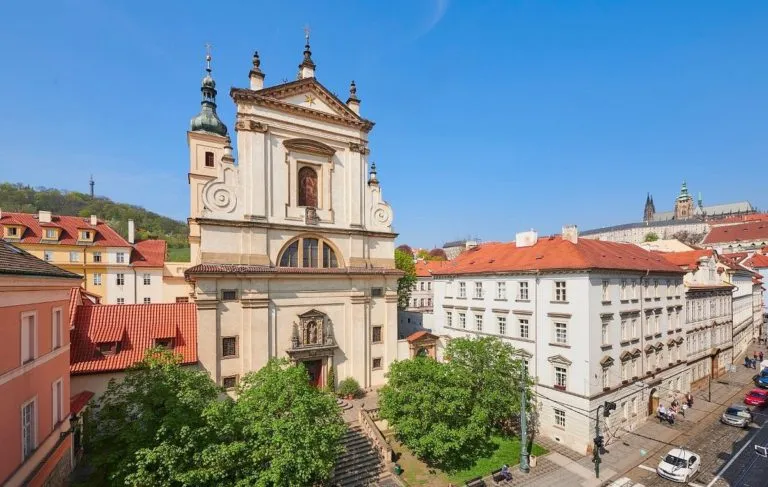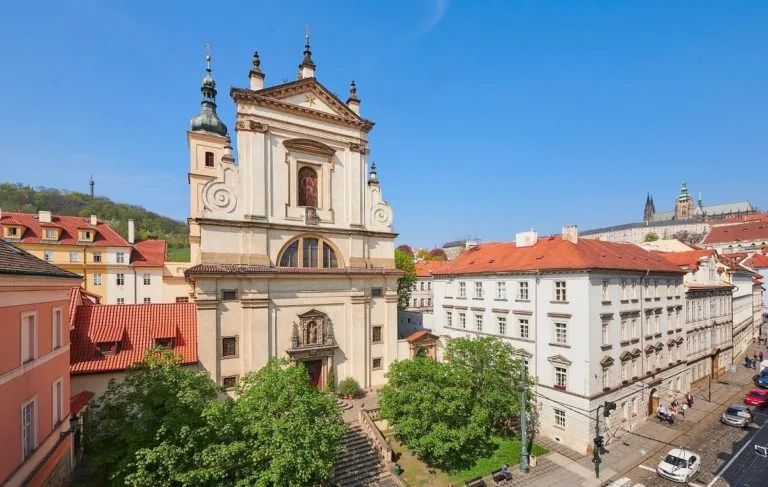
Introduction
The Church of Our Lady Victorious Prague, Czech Republic is one of the oldest church in Czech Republic. The Czech name for the church is Kostel Panny Marie Vítězné. The statue of the Infant Jesus of Prague is in the church of Our Lady Victorious in Mala Strana. The church of Our Lady Victorious date back to 1611 and was built partly in the renaissance style and partly in the baroque style. In 1620 it was taken over by the Carmelites who from 1636 to 1644 had the church reconstructed, giving it its current appearance.
The church is famous for its statuette of Infant Jesus of Prague, originally from Spain and donated to the Carmelites in 1628. Legend states that it once belonged to Santa Teresa of Avila. Outside the church copies of the statue are particularly popular in Portugal, Spain, the Philippines and Latin American countries.
History Of The Church
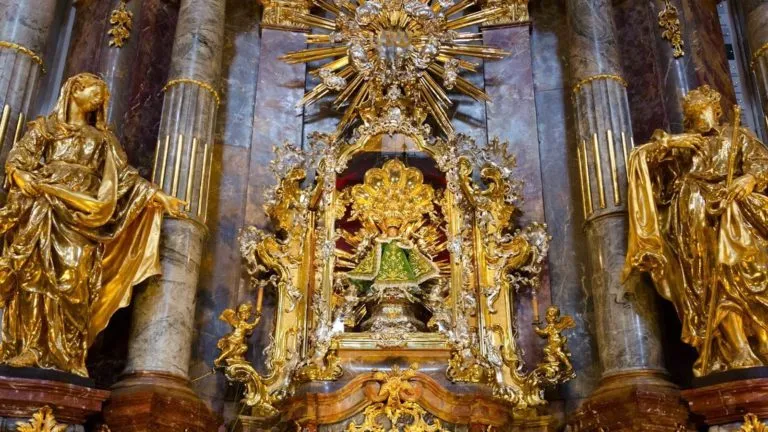
The Church of Our Lady Victorious is a quirky blend of history and devotion. The Church of Our Lady Victorious, located in the historic area of Prague known as Malá strana, is the home of the Infant Jesus. The church stands tall as a symbol of faith and devotion. Built in 1584, it was initially meant to be a larger church for German Protestants. Can you imagine the irony of it all? A Protestant church eventually becoming home to a Catholic icon! Talk about versatility!
The church was built by German speaking Lutherans in 1611 – 1613. On 21 July 1613 the church was consecrated to the Holy Spirit. After the Battle of the White Mountain in 1620, which resulted in the victory of the imperial pro-catholic part in the Czech lands, the Emperor Ferdinand II bestowed the church upon the order of Discalced Carmelites.
On 8 September 1624, the church was consecrated to Our Lady Victorious as a thank you for victory of the Battle of the White Mountain. St. Anthony of Padua became another patron of the church.
Today’s appearance of the church with the front facing the main street dates back to a reconstruction in 1636 – 1644. A large monastery for the Discalced Carmelites (today the office of the Ministry of Education, Youth, and Sports) was attached to the church on the South. A tower was built in 1669.
By decree of Emperor Joseph II, the monastery was dissolved in 1784. The Carmelites were forced to leave and the parish of the Church of Our Lady under the Chain was transferred there. The administration of the church was entrusted by the Archbishopric to the order of the Knights of Malta.
At the request of the Prague Archbishop Miloslav Vlk, the Discalced Carmelites returned to the church after two hundred years on 2 July 1993. Since that time this pilgrimage place, loved by people of many nationalities, has revived. The Carmelite Sisters of the Child Jesus help the Carmelites with the care of the gracious statue and the church. The pilgrimage church is under the parish administration of the Church of St. Thomas in Mala Strana.
Architecture of the Church
The church is partly built in the renaissance style, partly in the baroque style – built by German speaking Lutherans in 1611 – 1613. It is designed in the style of a Roman-type basilica. The name of the architect is not recorded; however, we presume it was the court architect to the Emperor Rudolf II, Giovanni Maria Filippy, of Italian origin. The presbytery with the altar were originally located on the eastern side where the front of the church is now. The entrance to the church was from side entrances, from the North and from the West.
Today’s appearance of the church with the front facing the main street dates back to a reconstruction in 1636 – 1644. A large monastery for the Discalced Carmelites (today the office of the Ministry of Education, Youth, and Sports) was attached to the church on the South. A tower was built in 1669.
The Discalced Carmelites furnished the church with altars made by the best available artists of the 17th and 18th Century. The appearance of the interior in the 18th century followed an uniform and thought-out concept. It presumably originated from the architect Ferdinand Schor. The statue of Infant Jesus of Prague was permanently placed in the church at this time.
The restoration of the main altar, spanning from 2006 to 2018, was a meticulous and multi-phase endeavour that breathed new life into the cherished centrepiece of the religious space. The initial phase, from 2006 to 2009, focused on the grand baroque painting situated beneath the arch, along with its ornate frame. This period laid the groundwork for subsequent years of careful restoration. In the following years, from 2010 to 2012, attention turned to the emblems of the Discalced Carmelites adorning the space above the side entrances, ensuring that every intricate detail was faithfully revived.
The restoration efforts continued their upward trajectory in 2011 to 2015, where the focus shifted to the four vases in the upper part of the altar. During this period, a comprehensive restoration of the upper section unfolded, encompassing the painting beneath the altar’s crown. This holistic approach ensured a harmonious rejuvenation of the entire upper segment.
In 2016, a specific vase on the left side of the moulding received dedicated attention, signifying the commitment to address every component of the altar individually. The subsequent year, 2017, marked the restoration of statues, further contributing to the altar’s overall splendour. Concurrently, from 2017 to 2018, the pillars and mouldings, adorned with golden decorations, underwent a meticulous restoration process, enriching the visual allure of the entire structure.
The culmination of this extensive restoration journey in 2018 involved the careful attention to detail given to a vase on the left side of the moulding. Each phase of the restoration, undertaken over these years, speaks to the dedication and expertise employed to preserve and enhance the historical and artistic significance of the main altar, ensuring it stands as a testament to both its past and its enduring future.

History Of the Infant Jesus of Prague statue
The statue of the Infant Jesus of Prague is more than 400 years old. It reflects God´s incarnation, spiritual childhood and the dignity of both Christ´s and our own humanity.
According to sources, the statue of the Prague Infant Jesus originates in Spain. It was probably made in Spain sometime in the second half of the 16th century or earlier. Legend says that the Infant Jesus miraculously appeared to the monk who moulded the statue based on his vision A different legend tells us that the statue was owned by St. Theresa of Jesus who greatly venerated Jesus’ childhood and spread the veneration of the Infant Jesus throughout Spain. She is said to have given the statue to friend whose daughter was getting married in Prague.
It an established fact that the statue of the Infant Jesus was brought to Prague by the Spanish Duchess Marie Manriquez de Lcara, who married Vrastislav of Pernstejn in 1556. Later she gave the statue to her daughter Polyxena of Lobkovic as a wedding gift. She greatly venerated the statue and received consolation and help from it many times.
Polyxena of Lobkowicz donated the statue as a precious gift to the monastery of Discalced Carmelites at the church of Our Lady Victorious. The Carmelites placed the statue in their novitiate chapel so that the young monks would learn the virtues of small Jesus. The novitiates greatly took to the statue and performed everyday worship before it. Later the novitiate was closed in Prague and the veneration of the Infant Jesus almost ceased.
In 1631 the Saxons seized Prague. The Carmelites fled from the monastery. The monastery was plundered and the Infant Jesus damaged and discarded as junk. The monks returned to Prague in 1637. With them was also Father Cyril of the mother of God, originally from Luxembourg, who remembered his time as a novice and the powerful intercession of the Infant Jesus. He found the statue among old junk. With great sorrow he discovered that both its arms had been broken off. During prayer he heard the Infant Jesus say: “Have mercy on me and I will have mercy on you. Give me my arms and I will give you, my peace. I will bless you as much as you will venerate me!” Eventually, Father Cyril was able to have new arms made for the Infant Jesus.
The Infant Jesus began to bless the monastery, the local people, and the entire city of Prague. He was credited with miraculous healing and amongst other things, with saving Prague during the Swedish siege in 1639. At that time the statue was in the choir where the believers could not worship it publicly.
In 1641 the statue was moved to a chapel in the church, on the left behind the entrance (today the St. Cross Chapel). In 1651 the statue was carried in processions to Prague churches. In 1655 the statue was crowned by the Bishop of Prague
The capacity of the chapel was no longer sufficient. Crowds of admirers were blocking the entry to the church. For this reason, in 1741 the statue was relocated to its present place on the right in the middle of the church nave. In 1776 a worthy altar was built for the statue.
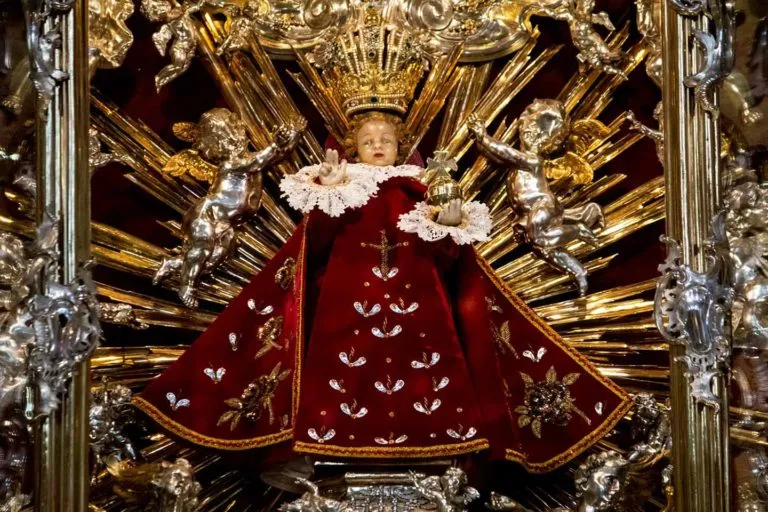
Description of the Statue
The statue is 47 cm tall and is made of wood with a moulded and coloured wax surface. Canvas shows though the wax. The statue represents Jesus at the age of 4-5 years. The face has a unique expression that cannot be captured by any copy. Moorish features can be seen in the face and in the hair, which was originally darker. This reflects the Spanish origin of the statue.
The Infant Jesus is dressed in a long under-robe beneath which we can see his bare feet. He blesses with his right hand and his left is holding the symbol of his rule over the world – an imperial orb ended with a cross.
His palm has a slot for attaching the orb. The statue is dressed in royal robes. In the past, the robes were decorated with precious jewels that came as gifts from worshippers. The most valuable jewel (since lost) was a copy of the Order of the Golden Fleece.
The small crown that currently adorns the Infant Jesus is a gift from Pope Benedict XVI, who crowed the Infant Jesus during his visit to Prague in 2009. The small crown in not placed directly on the statue, instead it is attached separately just above the Infant Jesus.
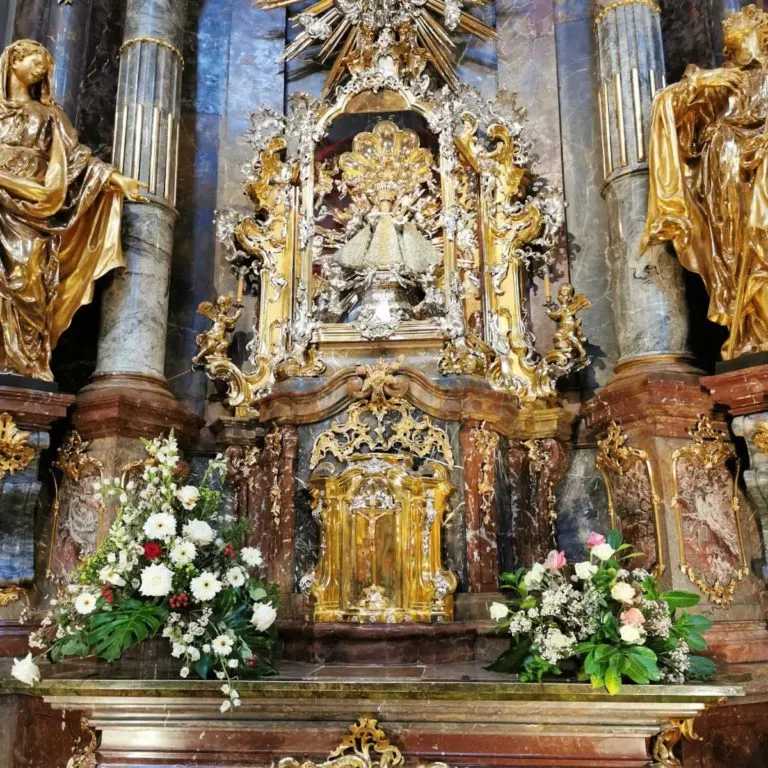
Dressing the Infant Jesus of Prague
People know the Infant Jesus of Prague mainly wearing his royal robes. Dressing the Infant Jesus emphasizes his real humanity – as mother dresses her child, so the Carmelite Sisters dress the small Jesus.
The actual robes, however indicate his Heavenly origin, his priestly, and royal majesty. The Infant Jesus, like the priests at the altar, is dressed in robes in the colour of a current liturgical season according to the church calendar. Generally, four basic colours are used:
- White at Christmas and Easter
- Red at Pentecost and the Feast of the Holy Cross
- Violet at period of Advent and Lent
- Green during liturgical year (most common colour)
Chapels Inside the Shrine of Infant Jesus of Prague
CHAPEL OF OUR LADY
The chapel of our lady is from the year 1626. It is dedicated to Madonna. In a class case is a gracious statue of the Madonna has been kept here. It is used as a confessional chapel.
CHAPEL OF ST. CROSS
The Infant Jesus was located here in 1656 – 1776. It was used as a chapel for blessing people and objects.
Museum

The Museum of the Infant Jesus of Prague showcases the rich tradition of adorning the statue with a diverse collection of attire. The museum have some of the historical robes as well as robes donated by people from various countries. The exhibit features:
- A robe gifted by Empress Maria Theresa.
- A donated robe from the renowned author Paolo Coelho.
- The crown presented by Pope Benedict XVI during his 2009 church visit.
- The Infant Jesus’ historical rococo-style crown.
- Garments originating from South Korea, the Philippines, Italy, Poland, and other nations.
- Captivating photographs capturing the statue’s dressing ritual.
- Life-sized images portraying the statue adorned in various liturgical-colored robes.
- An enthralling exhibition showcasing nativity scenes from diverse countries.
The stained glass windows of the cathedral were made by the master glassmaker from Nancy Jean-Jacques Grüber, to replace those pulverized by the German bombardments of the First World War. A stained glass window located in the western transept and made from 1927 to 1934, illustrates the consecration of the cathedral by Pope Eugene III on November 11, 1147.
Feast Day
Feast day – 1st Sunday of may
The coronation celebration of the gracious statue of the Child Jesus is celebrated every year on the first Sunday in May.
Mass Timing
Weekdays
9.00 am Czech mass
5.00 pm English mass – only Thursday
6.00 pm Czech mass
Saturday
9.00 am Czech mass
5.00 pm Spanish mass
6.00 pm Czech mass
Sunday
10.00 am Czech mass
12.00 noon English mass
5.00 pm French mass
6.00 pm Italian mass
7.00 pm Czech mass
Contact Info
Infant Jesus of Prague,
Karmelitská, Malá Strana,
Praga-Praha 1, Czech Republic.
Phone No.
Tel : +420 257 533 646
Accommodations
Connectivities
Airway
The nearest aiport to the shrine of infant jesus prague is Prague Airport which is just 10km away from the shrine.
Railway
The nearest railway station to the shrine of infant jesus prague is Prague main station which is just 4.6 km away from the shrine.

